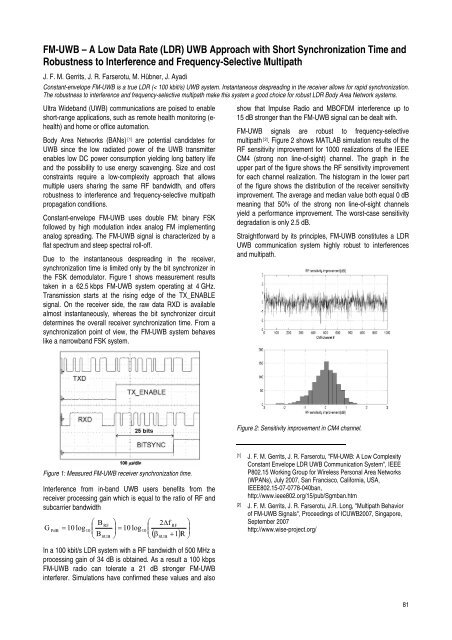research activities in 2007 - CSEM
research activities in 2007 - CSEM
research activities in 2007 - CSEM
You also want an ePaper? Increase the reach of your titles
YUMPU automatically turns print PDFs into web optimized ePapers that Google loves.
FM-UWB – A Low Data Rate (LDR) UWB Approach with Short Synchronization Time and<br />
Robustness to Interference and Frequency-Selective Multipath<br />
J. F. M. Gerrits, J. R. Farserotu, M. Hübner, J. Ayadi<br />
Constant-envelope FM-UWB is a true LDR (< 100 kbit/s) UWB system. Instantaneous despread<strong>in</strong>g <strong>in</strong> the receiver allows for rapid synchronization.<br />
The robustness to <strong>in</strong>terference and frequency-selective multipath make this system a good choice for robust LDR Body Area Network systems.<br />
Ultra Wideband (UWB) communications are poised to enable<br />
short-range applications, such as remote health monitor<strong>in</strong>g (ehealth)<br />
and home or office automation.<br />
Body Area Networks (BANs) [1] are potential candidates for<br />
UWB s<strong>in</strong>ce the low radiated power of the UWB transmitter<br />
enables low DC power consumption yield<strong>in</strong>g long battery life<br />
and the possibility to use energy scaveng<strong>in</strong>g. Size and cost<br />
constra<strong>in</strong>ts require a low-complexity approach that allows<br />
multiple users shar<strong>in</strong>g the same RF bandwidth, and offers<br />
robustness to <strong>in</strong>terference and frequency-selective multipath<br />
propagation conditions.<br />
Constant-envelope FM-UWB uses double FM: b<strong>in</strong>ary FSK<br />
followed by high modulation <strong>in</strong>dex analog FM implement<strong>in</strong>g<br />
analog spread<strong>in</strong>g. The FM-UWB signal is characterized by a<br />
flat spectrum and steep spectral roll-off.<br />
Due to the <strong>in</strong>stantaneous despread<strong>in</strong>g <strong>in</strong> the receiver,<br />
synchronization time is limited only by the bit synchronizer <strong>in</strong><br />
the FSK demodulator. Figure 1 shows measurement results<br />
taken <strong>in</strong> a 62.5 kbps FM-UWB system operat<strong>in</strong>g at 4 GHz.<br />
Transmission starts at the ris<strong>in</strong>g edge of the TX_ENABLE<br />
signal. On the receiver side, the raw data RXD is available<br />
almost <strong>in</strong>stantaneously, whereas the bit synchronizer circuit<br />
determ<strong>in</strong>es the overall receiver synchronization time. From a<br />
synchronization po<strong>in</strong>t of view, the FM-UWB system behaves<br />
like a narrowband FSK system.<br />
Figure 1: Measured FM-UWB receiver synchronization time.<br />
Interference from <strong>in</strong>-band UWB users benefits from the<br />
receiver process<strong>in</strong>g ga<strong>in</strong> which is equal to the ratio of RF and<br />
subcarrier bandwidth<br />
G<br />
PdB<br />
= 10 log<br />
10<br />
⎛ B<br />
⎜<br />
⎝ B<br />
RF<br />
SUB<br />
⎞<br />
⎟<br />
= 10 log<br />
⎠<br />
10<br />
⎛<br />
⎜<br />
⎝<br />
2Δf<br />
⎞<br />
( ) ⎟ RF<br />
β + 1 R<br />
SUB<br />
In a 100 kbit/s LDR system with a RF bandwidth of 500 MHz a<br />
process<strong>in</strong>g ga<strong>in</strong> of 34 dB is obta<strong>in</strong>ed. As a result a 100 kbps<br />
FM-UWB radio can tolerate a 21 dB stronger FM-UWB<br />
<strong>in</strong>terferer. Simulations have confirmed these values and also<br />
⎠<br />
show that Impulse Radio and MBOFDM <strong>in</strong>terference up to<br />
15 dB stronger than the FM-UWB signal can be dealt with.<br />
FM-UWB signals are robust to frequency-selective<br />
multipath [2] . Figure 2 shows MATLAB simulation results of the<br />
RF sensitivity improvement for 1000 realizations of the IEEE<br />
CM4 (strong non l<strong>in</strong>e-of-sight) channel. The graph <strong>in</strong> the<br />
upper part of the figure shows the RF sensitivity improvement<br />
for each channel realization. The histogram <strong>in</strong> the lower part<br />
of the figure shows the distribution of the receiver sensitivity<br />
improvement. The average and median value both equal 0 dB<br />
mean<strong>in</strong>g that 50% of the strong non l<strong>in</strong>e-of-sight channels<br />
yield a performance improvement. The worst-case sensitivity<br />
degradation is only 2.5 dB.<br />
Straightforward by its pr<strong>in</strong>ciples, FM-UWB constitutes a LDR<br />
UWB communication system highly robust to <strong>in</strong>terferences<br />
and multipath.<br />
Figure 2: Sensitivity improvement <strong>in</strong> CM4 channel.<br />
[1] J. F. M. Gerrits, J. R. Farserotu, "FM-UWB: A Low Complexity<br />
Constant Envelope LDR UWB Communication System", IEEE<br />
P802.15 Work<strong>in</strong>g Group for Wireless Personal Area Networks<br />
(WPANs), July <strong>2007</strong>, San Francisco, California, USA,<br />
IEEE802.15-07-0778-040ban,<br />
http://www.ieee802.org/15/pub/Sgmban.htm<br />
[2] J. F. M. Gerrits, J. R. Farserotu, J.R. Long, "Multipath Behavior<br />
of FM-UWB Signals", Proceed<strong>in</strong>gs of ICUWB<strong>2007</strong>, S<strong>in</strong>gapore,<br />
September <strong>2007</strong><br />
http://www.wise-project.org/<br />
81








